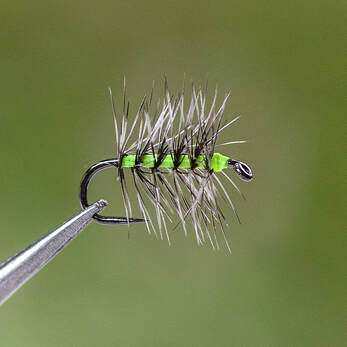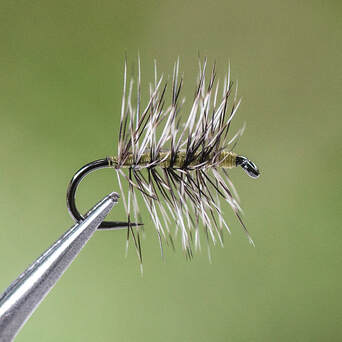Fly of the Month 08.20
Similar flies are called palmers or cracklebacks or woolly worms or Griffith gnats depending on the size and material combination. Like the Asher, these are all simple fly patterns to tie that only use a body material and a palmered hackle and an optional tail. However, the Asher has evolved much like the Griffith gnat to be an excellent representation of a midge cluster.
Ginger Asher
Lime Asher
Olive Asher
Orange Asher
Sulphur Asher
The Orange Asher was invented in the 1970s as an adult midge or midge cluster imitation for the high-mountain lakes by Jack Howrath of Colorado Springs, Colorado. Other color version of the Asher has evolved as various midges and other tiny insects may be represented with such a simple fly pattern as well.
The Lime Asher is an excellent fly pattern to suggest or imitate green insects such as a clump of aphids or Katydids as well as various caterpillars. We use the Olive Asher on the South Holston River and Watauga River in Tennessee to imitate tiny Blue Winged Olives (BWOs). We use the Ginger Asher and Sulphur Asher respectively, to imitate Pale Morning Duns, Pale Evening Duns and Sulphurs at times when the silhouette of the fly is less important and matching the small size is more important.
When running low on flies, the Asher can be tied in numbers in very little time. It is very durable and highly buoyant – superior to the traditional adult midge (hackle collar and no wing) fly patterns.
Fly of the Month 08.20
Tom Adams and Alen Baker
Similar flies are called palmers or cracklebacks or woolly worms or Griffith gnats depending on the size and material combination. Like the Asher, these are all simple fly patterns to tie that only use a body material and a palmered hackle and an optional tail. However, the Asher has evolved much like the Griffith gnat to be an excellent representation of a midge cluster.
Ginger Asher
Lime Asher
Olive Asher
Orange Asher
Sulphur Asher
The Orange Asher was invented in the 1970s as an adult midge or midge cluster imitation for the high-mountain lakes by Jack Howrath of Colorado Springs, Colorado. Other color version of the Asher has evolved as various midges and other tiny insects may be represented with such a simple fly pattern as well.
The Lime Asher is an excellent fly pattern to suggest or imitate green insects such as a clump of aphids or Katydids as well as various caterpillars. We use the Olive Asher on the South Holston River and Watauga River in Tennessee to imitate tiny Blue Winged Olives (BWOs). We use the Ginger Asher and Sulphur Asher respectively, to imitate Pale Morning Duns, Pale Evening Duns and Sulphurs at times when the silhouette of the fly is less important and matching the small size is more important.
When running low on flies, the Asher can be tied in numbers in very little time. It is very durable and highly buoyant – superior to the traditional adult midge (hackle collar and no wing) fly patterns.
Fly of the Month 08.20
Tom Adams and Alen Baker
Asher
HOOK : Dry Fly, standard length. Tiemco 100 or equivalent. Size 14,16,18,20,22
THREAD : 8/0 Uni color to match insect- orange, lime, and olive or your choice
ABDOMEN: Thread body, wrapped in touching turns
HACKLE : Grizzly rooster hackle
Directions :
HOOK : Dry Fly, standard length. Tiemco 100 or equivalent. Size 14,16,18,20,22
THREAD : 8/0 Uni color to match insect- orange, lime, and olive or your choice
ABDOMEN: Thread body, wrapped in touching turns
HACKLE : Grizzly rooster hackle
Directions :
- Begin thread wraps two or three eyelengths back from eye and wrap tightly to the hook bend. Return the thread one third toward the hook eye. Let the bobbin hang.
- Select grizzly rooster hackle to match the hook size. Barbs about one and one half the hook gap. Strip the barbs from the stem exposing about 3/16ths bare stem. This is a palmered pattern, so the “curve” of the barbs is toward the eye. When tying the hackle in, leave enough stem exposed to make one full wrap of the hackle without any barbs. This will prevent accidentally trapping barbs in an irregular fashion when wrapping. At the hook bend, hold the stem at a 45 degree with the stem pointing down, on the side of the shank closest to you and tie in with one or two soft wraps and finish with firm wraps at the hook bend.
- Continue making wraps of thread in touching turns to three eyelengths from the eye. Let the bobbin hang.
- Palmer the hackle to the eye leaving a small space between wraps. Stop at the thread and make it secure with two or three thread wraps. Trim the waste hackle. Form a small thread head, whip finish to complete.


